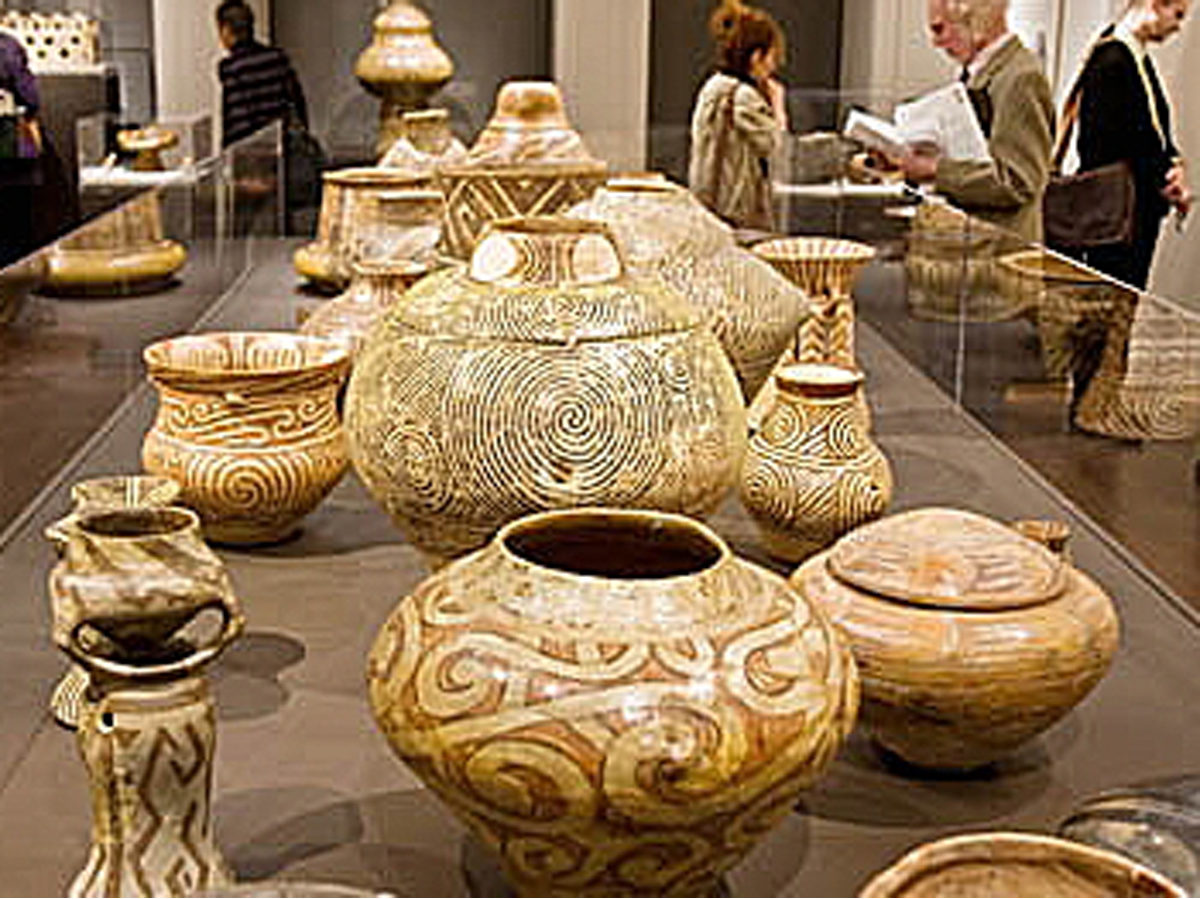In 4500 B.C., before the invention of the wheel or writing, before the first cities were built in Mesopotamia and Egypt, Old Europe was among the most sophisticated and technologically advanced places in the world.
— David W. Anthony (ed.), The Lost World of Old Europe, p.29
(hereafter cited as Lost World)
The Lost World of Old Europe
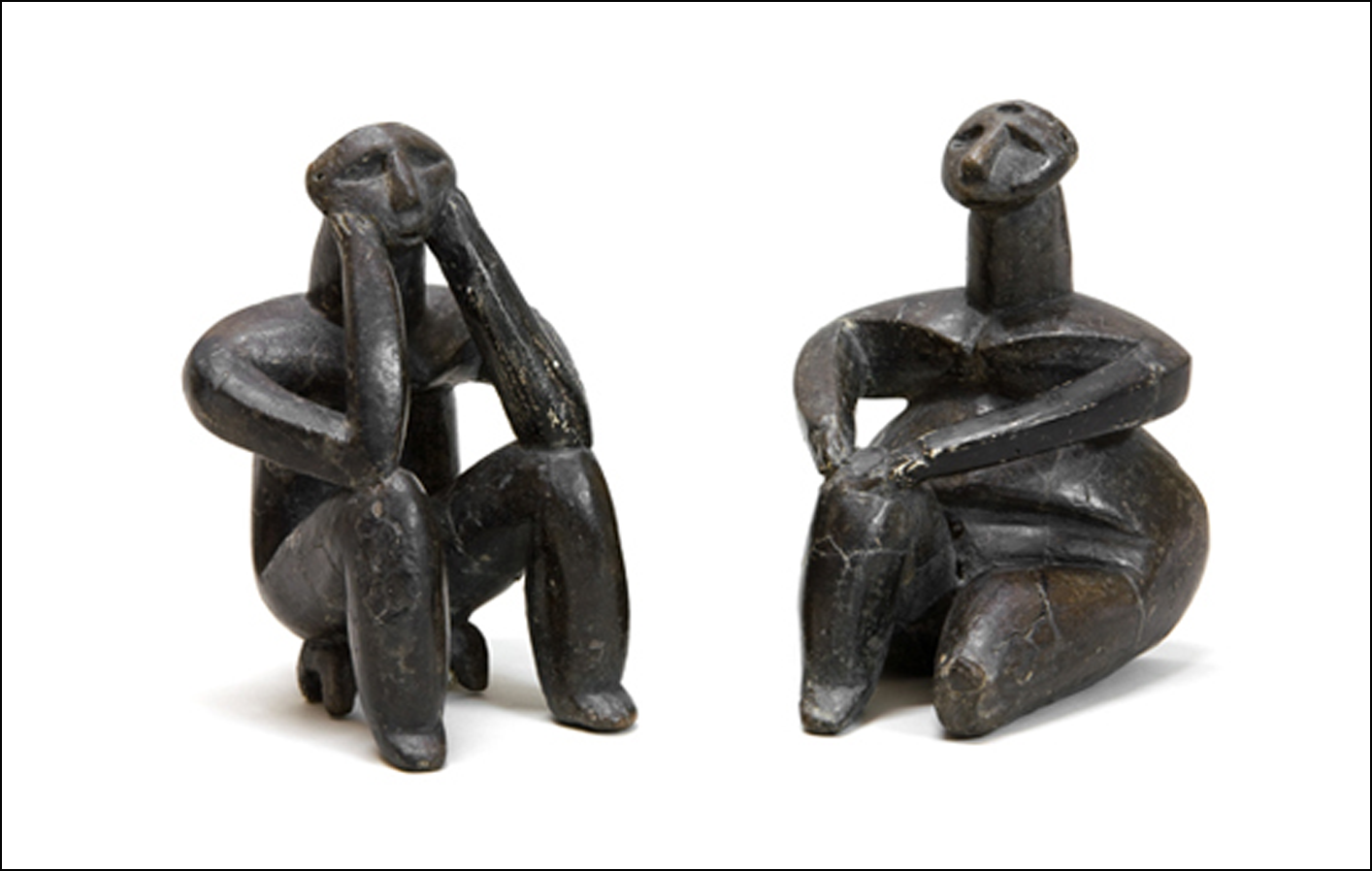
In honor of Rodin, let’s call the 7000-year-old couple above The Thinkers. Are they just thinking? Or mourning? They’re Europeans. Their facial expressions, their elongated necks, their heads tilted wistfully upwards, their attentive miens tell two tales. The first is the experience of the subjects, lost in thought and sorrow; the second is the consciousness of the prehistoric artist who sculpted these figures with such poignant focus. I’m far from the first to call these figures The Thinkers, but in fact it was my first thought when I saw them. This couple is genuinely modern. They are us.
The next image, also a thinker, has the same poignancy, reflecting consternation, hardship, beauty, and the artist's ownership of his art.
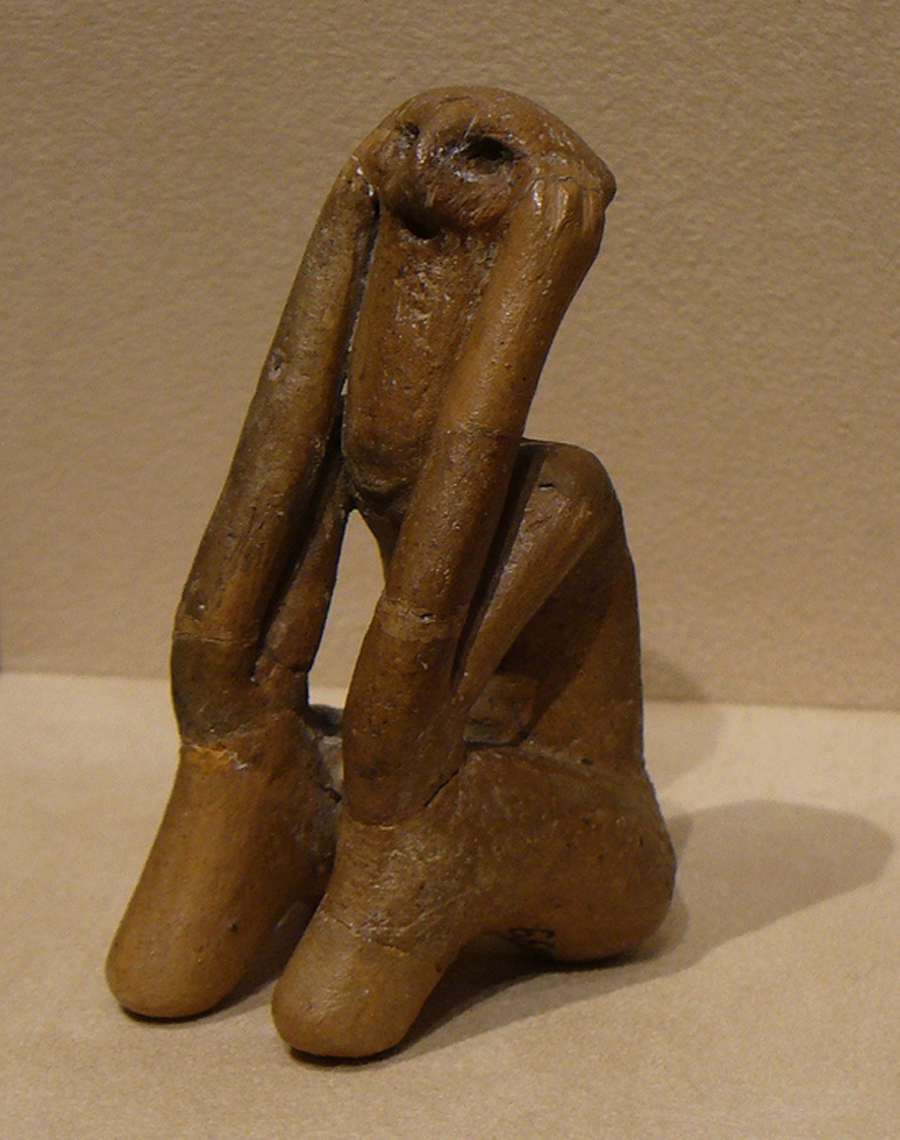
And what of the figure below, lost in undefended grief—has he lost a wife or child? These figures could all be mistaken for modern art.
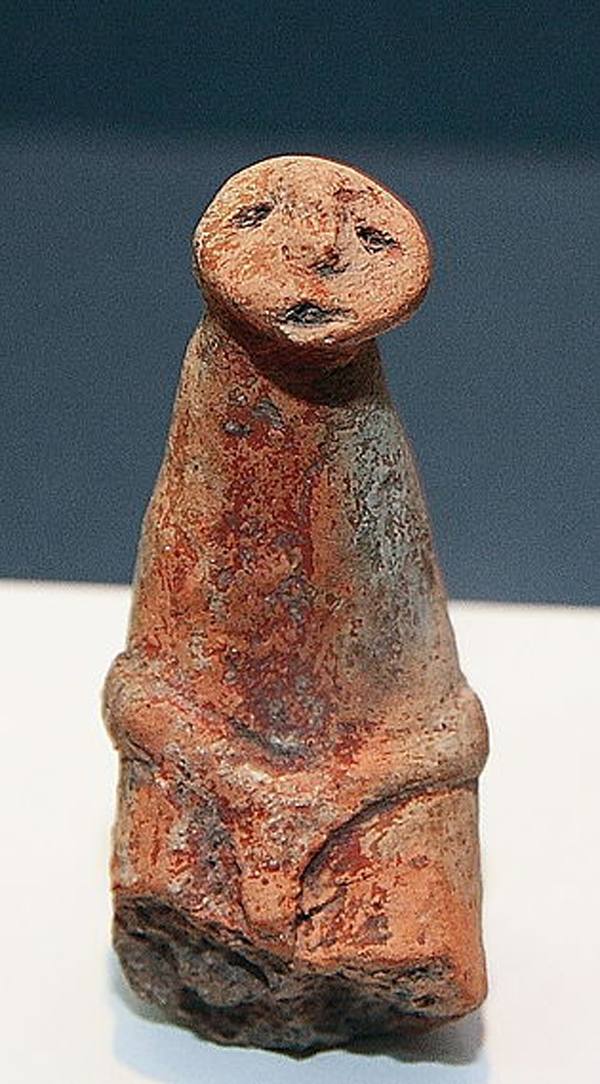
We live with a pleasing assumption that progress is a fact of life. We like to measure our progress, individually and generationally, and don't usually think much about prehistoric cultures. Ancient Egypt, Greece, and Rome provide an easy and satisfying enough palette of antiquity, with their temples and edifices that we can still walk around.
If anything, we’re fixated on the future. But some discoveries upturn popular notions learned in the classroom. From roughly 6000 BC to 3500 BC, southeastern Europeans in what is now Romania, Bulgaria, and Moldova, in areas along the Black Sea coastline, up the Danube River as it meandered on its way north and west, and in nearby areas eastward into the Pontic steppe in what is now southern Ukraine, had a thriving, evolving culture.
They produced our “Thinkers” and much other art. They developed extraordinary skills in ceramics and metallurgy, to an extent far greater than required to sustain a neolithic lifestyle. Their designs and subject matter show a high level of artful play and seriousness. With tools and kilns they made by hand, the quality of their work rivals anything produced today. And their art tells us that we haven't changed much since then.
Look at the graceful slope of the nursing mother's body (below) and the gentle position of her arms and hands enfolded on her baby. It is all quite refined. The only thing missing is the artist's signature.
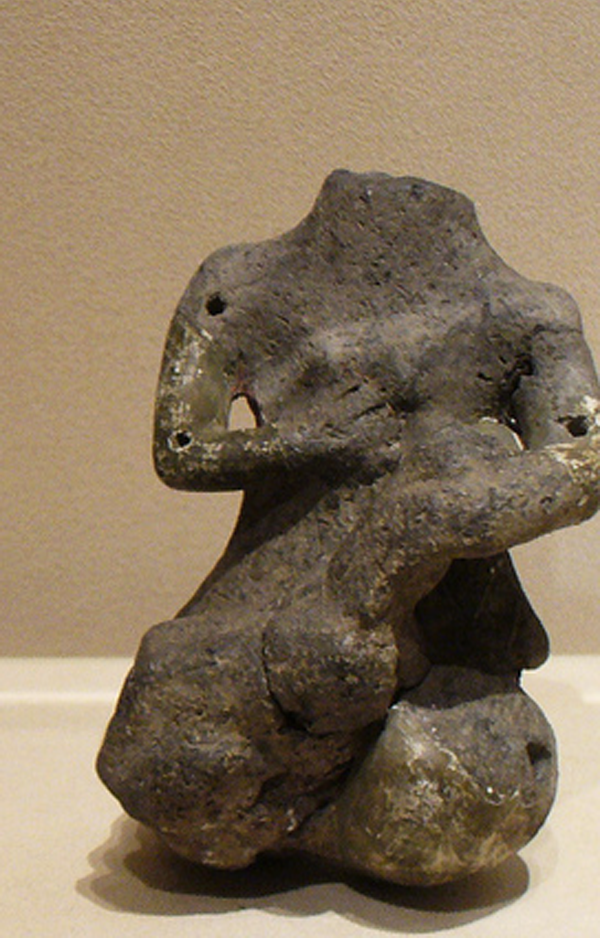
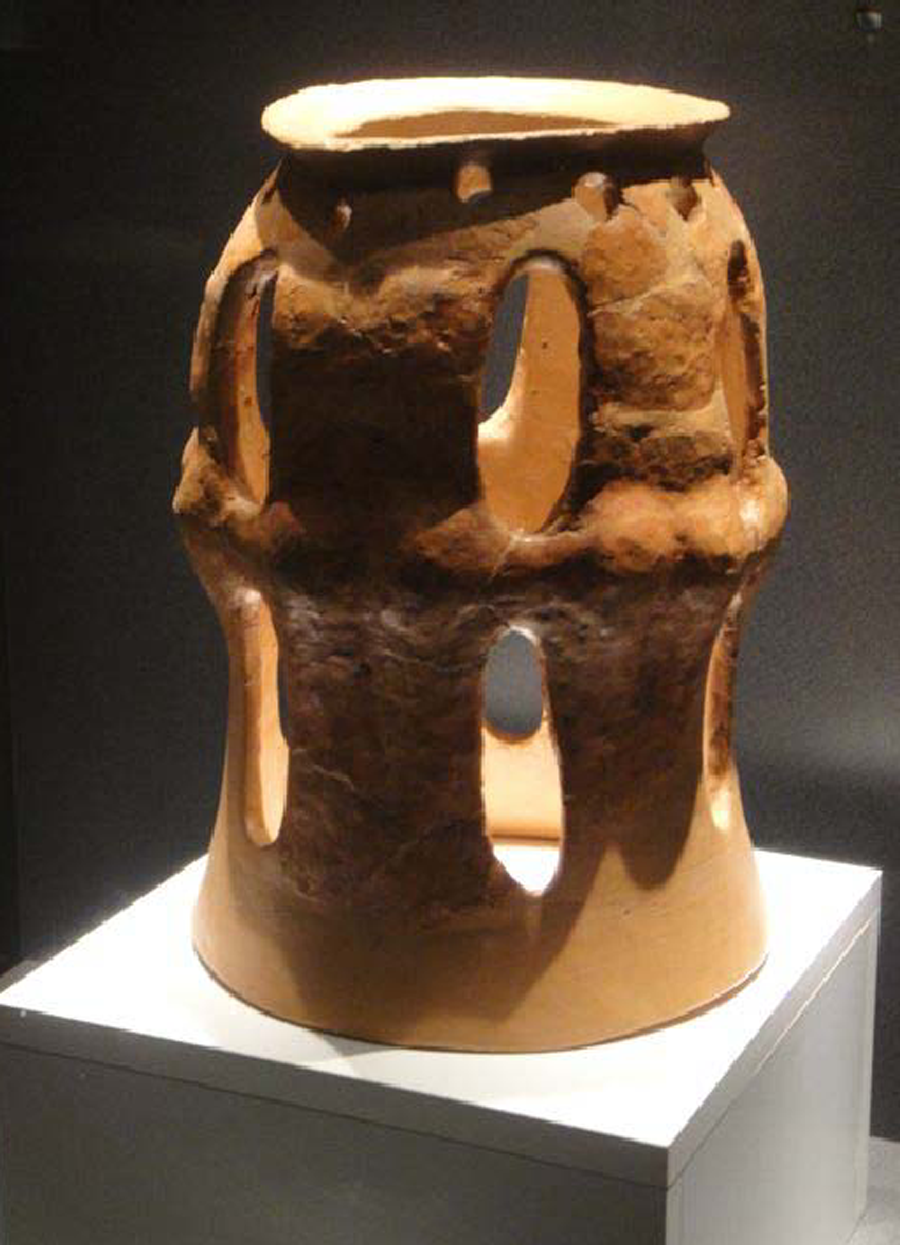
This 6000-year-old ceramic of female dancers has been called The Hora. We can almost see the circular rapidity of the dancers' steps and hear the musicians playing (What were their instruments?). The evidence of culture these early Europeans left behind makes me wonder what their stories were about. Their grandparents? Their tribes? Their heroes?
The skilled ceramicists and metallurgists of this era applied a mathematical precision to their work. The image below of one male and two female gold idols found in Cucuteni, Romania shows the technical sophistication of their gold work. Metallographic analysis revealed that these pieces are made of numerous overlaid gold leaves, tapped with a stone hammer so tightly they appear welded together.

These Old Europeans had trade networks with inventory and supply chains—activities not usually associated with prehistoric times—and they were sophisticated merchants. David Anthony, citing a 1991 study called “Prehistoric Copper in Bulgaria” in the journal Eurasia Antiqua, notes that:
The metal artifacts recovered by archaeologists from Old Europe total about 4,700 kilograms (more than five tons) of copper, and over six kilograms (13.2 pounds) of gold, more metal by far than has been found in any other part of the ancient world dated before 3500 B.C. (Anthony, as cited in Lost World, p.29)
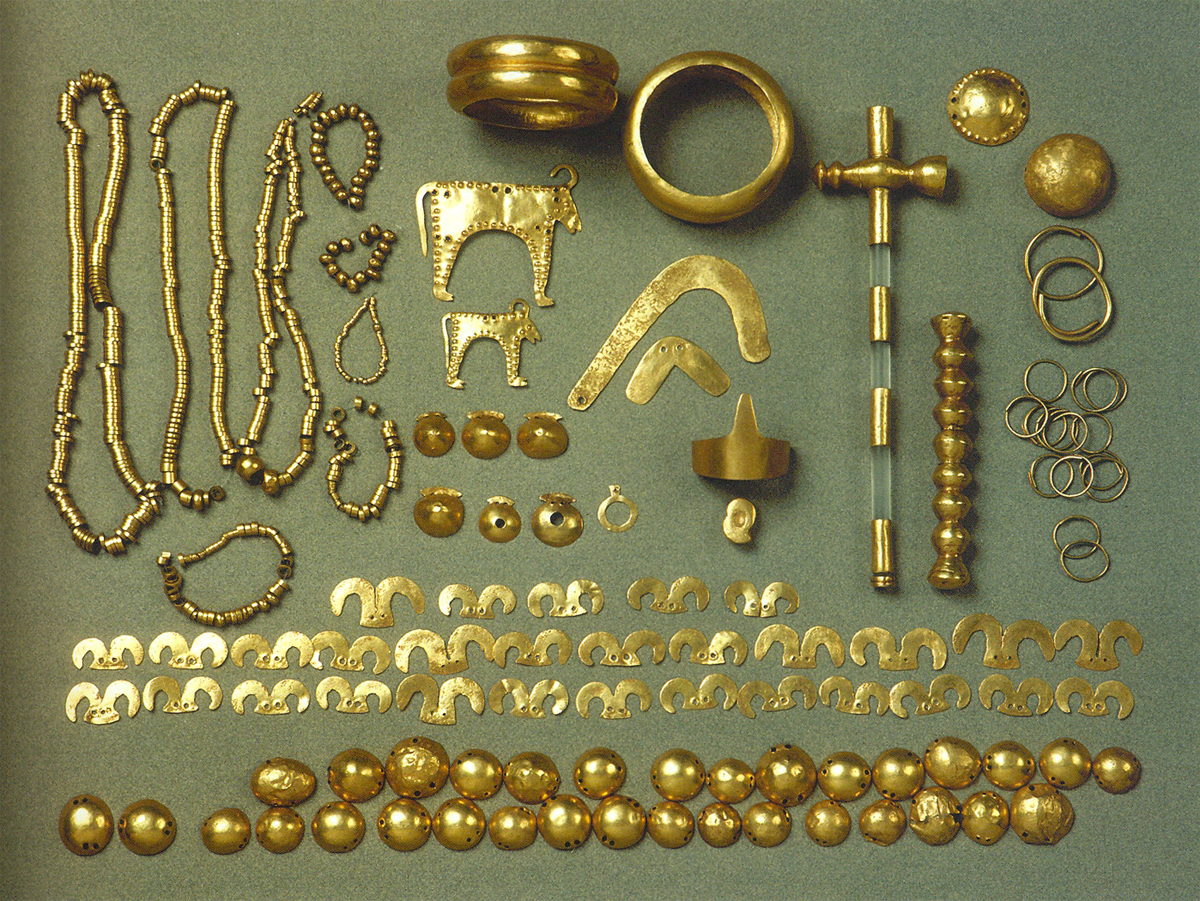
Because so much gold was found in only a few gravesites (see photo above), and none in others, experts believe this is evidence of an elite class of neolithic chiefs in this culture. But David Anthony notes that there is no evidence that elite individuals or families lived any more richly in their private lives than ordinary people. "[D]isplays of opulence [in the gravesites] still surprise and puzzle archaeologists, because there was no equivalent distinction in private houses" (Lost World, p.29). The chief who wore the gold at public events went home to an ordinary house, says Anthony.
This fact makes me think of Native American chiefs who donned bear skins and ornamental bands on their wrists and ankles to perform rituals and sacred rites. The garment (i.e. the bear skin) is what imparted the power to the chief. Native American chiefs also went home to ordinary dwellings among their people. The sacred object conferred strength, spirituality, and safety from harm. The chief was the agent of its power, but the power was transferrable.
The Institute for the Study of the Ancient World—ISAW
In 2009, I visited New York University’s Institute for the Study of the Ancient World, a center for advanced scholarly research and graduate education. It's not on the NYU campus, but is located in a beautiful limestone townhouse on 84th Street in Manhattan. Founded in 2006, its website states that it aims "to encourage particularly the study of the economic, religious, political and cultural connections between ancient civilizations."

I had seen an advertisement for an exhibit called “The Lost World of Old Europe: the Danube Valley 5000-3500 BC,” an unusual headline that pulled on a joyous curiosity in me. I made three trips that fall to the exhibit.
The large map on the institute's entrance wall, with swirling, pointing arrows from the Levant through Turkey, Greece, and into Bulgaria and Romania was an exciting introduction, but not a clue as to the treasures inside. I was trying to understand why I had never heard of these people (The reasons are their own interesting story.).
The layout of the items is still fresh in my mind. More than 250 artifacts were on display, including those shown above, on loan from museums in Bulgaria, Moldova, and Romania. There were multiple gold pieces, ceramic ensembles of men and women in different kinds of groupings, lots of female figurines, clay models of houses and buildings, tools, and beautiful household pottery, among other things. What didn’t make sense was that these pieces were between 5,500 and 8,000 years old. The sophistication on display didn’t align with any idea of “prehistory.”
ISAW gave the United States its first-ever exhibit of these wonderful objects. The curators presented them without a rush to opinionated conclusions about their meaning. Excavations are not completed across the Old Europe sites, and the exhibit maintained an appropriate sense of mystery and surprise.
The catalogue accompanying this exhibit was no ordinary flyer, not even an ordinary catalogue. It was a large and beautiful volume published by New York and Princeton University presses, with chapters written by archaeological experts from Romania, Bulgaria, Moldova, Germany, France, and the United States.
In the video below, David Anthony of Hartwick College, who edited the catalogue, talks about the Institute and the Lost World exhibit.
I must say here that the typing, numbering, and cataloguing of found items, the intricacies of footnoted distinctions and addenda, as important as they all are, are not my focus here. I leave that to the archaeologists and curators, to whom one must offer humble gratitude for all of their work.
My interest is that this ancient culture existed; that it had distinct but interconnected towns, highly appealing products, and sophisticated production methods. Like their meso-/neolithic Irish counterparts (see Ancient Astronomers on this website), the neolithic inhabitants of southeastern Europe did not leave us with a written historical record. Otherwise, they were purposefully engaged in culture-making and were hardly what we think of as "prehistoric."
There is a consensus among archaeologists that women were the primary ceramicists and kiln makers. Cornelia-Magda Lazarovici, an archaeologist at the Institute of Archaeology in Iaşi, Romania, notes that kiln technology in the Cucuteni period (4600 BC) improved to the point of permitting:
... better control over the evenness of firing and the gaseous atmosphere during firing; the discovery in nature of manganese minerals that could make a pigment that retained a strong black color during firing; and the development of various kinds of colored slips that could provide a base color of varied hues before firing. These innovations elevated Cucuteni ceramic production ... to a specialized skill that produced objects of consummate beauty. (Lazarovici, Lost World, p.133)
Lazarovici states that that the Copper Age actually started in the early Cucuteni culture, when:
... artisans working with high-temperature kilns (intended for pottery manufacture) learned how to smelt natural mineral ores (malachite and azurite) in order to extract pure copper metal from these green and blue rocks. (Lazarovici, Lost World, p.130)
The clay used in the ceramics contained quartz, feldspar, muscovite, mica, magnetite, and hematite, and the ceramacists used broken and pounded pottery shards as a tempering agent. And the variety they produced?
The repertory ... included goblets, globular vessels, biconical vessels, bowls, jars, pear-shaped (pyriform) vessels, tureens, vessels and cups on pedestals, pedestaled support vessels, handled lids, and others. ... Innovative shapes included numerous vessels with bulging and flattened bodies, crater-shaped tureens with wide-open mouths, ... and goblets. (Lazarovici, Lost World, p.131)
Later forms included ingeniously shaped goblets, vessels with bodies that curved out, short cups, small bowls, "fruit dish" vessels, and artistically original anthropomorphic and zoomorphic vessels of all kinds.
Unlike later Greek pottery, which used decoration to tell stories, Old Europeans experimented with different shapes and designs for their own sake. They applied geometrically balanced spheres, spirals, and zigzags; combined complementary design elements and stamped motifs, also with a geometrical precision; and created colors and polishes for the finished look. There is artistic and technical freedom and excitement in these objects. There is material enjoyment and wealth creation. We can see their inventiveness in the slideshow below.
People of the Lost World
The 3500-year progression of neolithic culture in the Danube Valley was not unified, did not exist in a vacuum, and did not begin suddenly, fully formed like Athena from the head of Zeus. Scholars do not agree on the routes early and later neolithic migrants took to their European settlements, or that they originated primarily in Greece or Anatolia, or even that they were all migrants.
The journey into Europe was via water. The seas and waterways were the roads most traveled, much easier to navigate than arduous overland terrain with its inevitable unhappy surprises. Barry Cunliffe, in his book Europe Between the Oceans: 9000 BC – AD 1000, posits that mesolithic peoples from the Levant and North Africa were expert sailors and that they had a number of routes mapped out.
Water brought you to other ports, other people, and made trade and interaction possible. This is very interesting: ancient cultures could not have achieved what they did without recognition of their similarities and differences when they encountered other groups.
This map shows the major areas of archaeological interest in the Balkans and the migrant routes likely taken:

Image © Jonathan Corum, http://13pt.com/corum/ Used by permission.
The map below shows the extent of ancient settlements from west to east, known as the Cucuteni-Trypillia region, which includes areas in Ukraine.
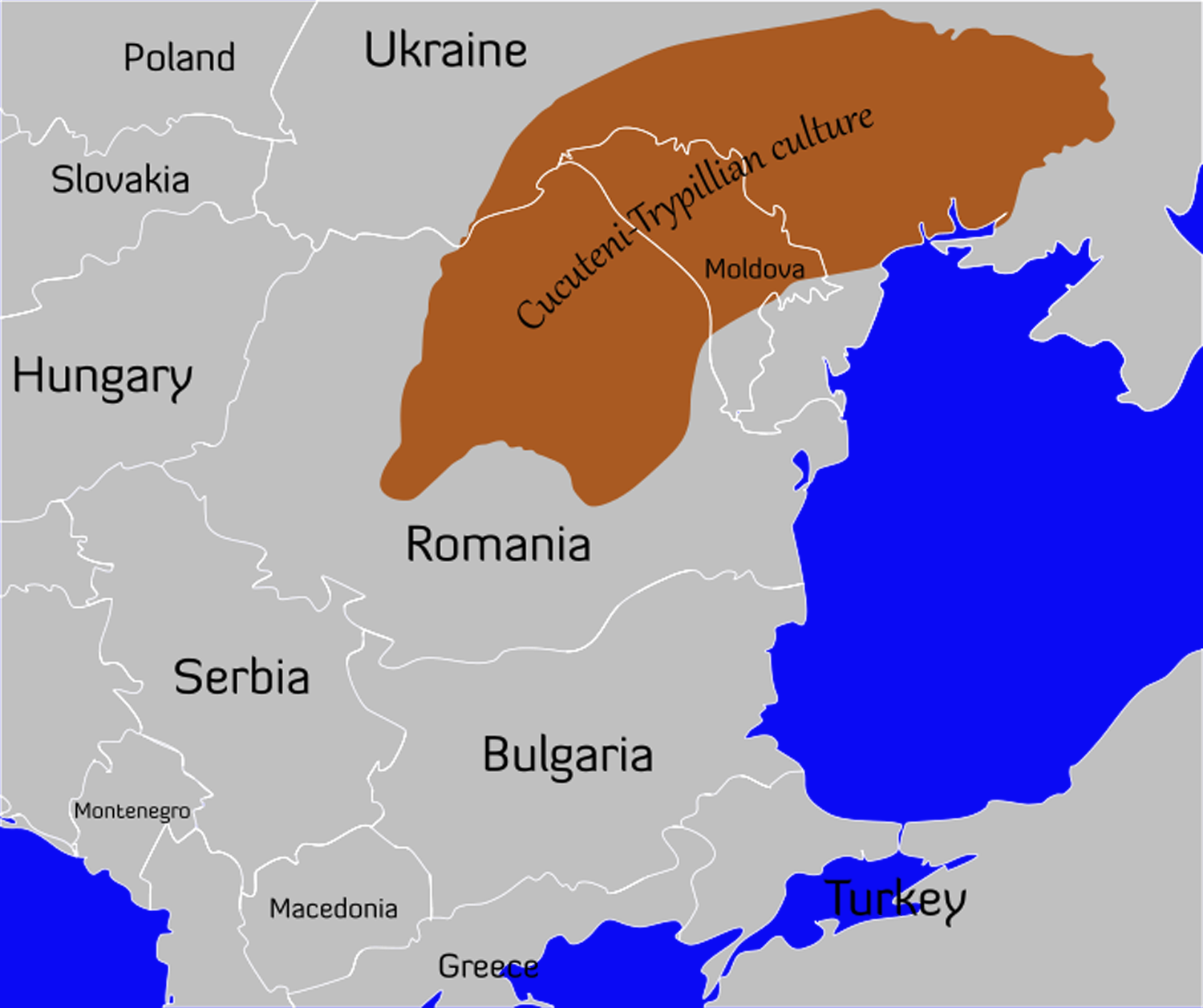
Wikimedia Commons, public domain. Found on Dirk's blog at the
Houston Museum of Natural Science: http://blog.hmns.org
The third map, below, shows the points at which the Danube River flows from Romania into the Black Sea. Experts seem to agree that the routes on the first map were primary, but the Black Sea itself is a direct route into the Balkans. The Black Sea is bounded by many countries, among them ancient Bulgaria, Romania, Turkey, and Ukraine. Not only does the Danube empty into the Black Sea in a number of estuaries, but many other rivers flow into the Danube or empty into the Black Sea, among them the Prut, Bug, Dnieper, and Dniester.

The timelines for the high neolithic culture of the Danube Valley and Pontic steppe, what we might call the "golden age" of Old Europe, are quite broad and overlap one another. Three of the well-known cultures represented at ISAW (there are subdivisions and related groups) are:
- Hamangia culture, circa 6000-4800 BC, named after a site found close to the Black Sea coast in Baia-Hamangia, along Lake Goloviţa, an area that now encompasses part of both Romania and Bulgaria. It developed into the succeeding Gumelnița, Boian, and Varna cultures, which produced the extraordinary gold found at the Varna necropolis (photo above).
- Pre-Cucuteni culture, circa 5050-4600 BC, in eastern Romania and parts of Moldova and Ukraine. Experts distinguish this culture from the later Cucuteni and Cucuteni-Trypillia cultures, which had larger settlements and some difference in their customs.
- Cucuteni and Cucuteni-Trypillia culture, about 4600-3500 BC, in parts of Romania, Moldova, and southern Ukraine. Named for the village of Cucuteni in Iași County, Romania, and Trypillia in Ukraine. This culture, with some villages the size of cities, had mature production methods in ceramics and metals.
There are complexities involved in further stratifying these cultures. When discoveries are made on one's own turf, the human tendency is to want to claim an ownership stake, even when we are talking about people who lived six or eight thousand years ago whose rituals were far from our own. Some scholars want to believe that cultural refinements moved from east (modern Russia) to west (modern Moldova/Romania); the opposite sentiment is held by countries west of Russia.
Yet Old Europe is situated north of the Middle East, west of Eurasia, and east of western Europe: a place where traditions from all three regions likely converged, at least somewhat, and grew. For a short description of the cultural ownership issue, see the discussion of Origins and Chronology posted in 2011 on Dirk's Blog from the Houston Museum of Natural Science. The writer also gives an interesting quote from David Anthony on the difficulty of categorizing the cultural phases outlined above.
Neolithic, I discovered, doesn't refer to one timeline, and can refer to several. The term denotes a level of societal achievement, what Barry Cunliffe calls "the neolithic package": stone tools, pottery, rectangular timber houses, cultivation of grain, and domestication of animals. It also denotes a tribe's sense of permanence in its location.
Early neolithic settlements were already in full swing in 7000 BC in Thessaly, says Cunliffe, and the settlers there had come with their neolithic package already in tow.
Nor does mesolithic refer to a strict time period. Some neolithic migrants found themselves face to face with indigenous mesolithic people who had their own "packages" and life skills, when the newcomers found their way into the southern Balkans. A mesolithic way of life continued for years with some groups and may have been preferred; their mapped-out nomadic route was its own kind of permanent settlement.
Cunliffe says the neolithic migrants may have made the passage from southwest Asia or the Middle East with the help of skilled mesolithic seafarers, who had made a sort-of business of transporting the migrants, along with their animals, grains, and artifacts. This was no mean feat; it would require navigational skills, the ability to calculate weights and required space, and boats capable of handling the loads. The two interacting groups would have benefited from the exchange.
This is curious, and interesting. If true, then both mesolithic and neolithic people of this region developed solid trading instincts. Neolithic denotes agriculture and sedentary life; mesolithic, hunting and moving about. But if both groups also depended on trading their skills and wares, simultaneously, we could use other modifiers, like ingenious, creative, ambitious, democratic.
The Old Europeans became so used to dealing with each other that their community and trade relations went far beyond agricultural interests and were spread over hundreds of miles. Over time they likely borrowed customs from one another and intermarried. Acceptance of differences; knowledge of land surveyance and soil types, grains, and husbandry; a system of what constitutes fair exchange; and continuous industrial development and its attendant trial and error methods kept the varied cultures growing and interconnected.
What fascinates me beyond the carbon dating of objects is the cultural development — the mind at work, if you will — and the sense of at least partial control over one's life that it provided. These busy, inventive Old Europeans had enough stability to expect their grandchildren to continue and to improve upon their traditions.
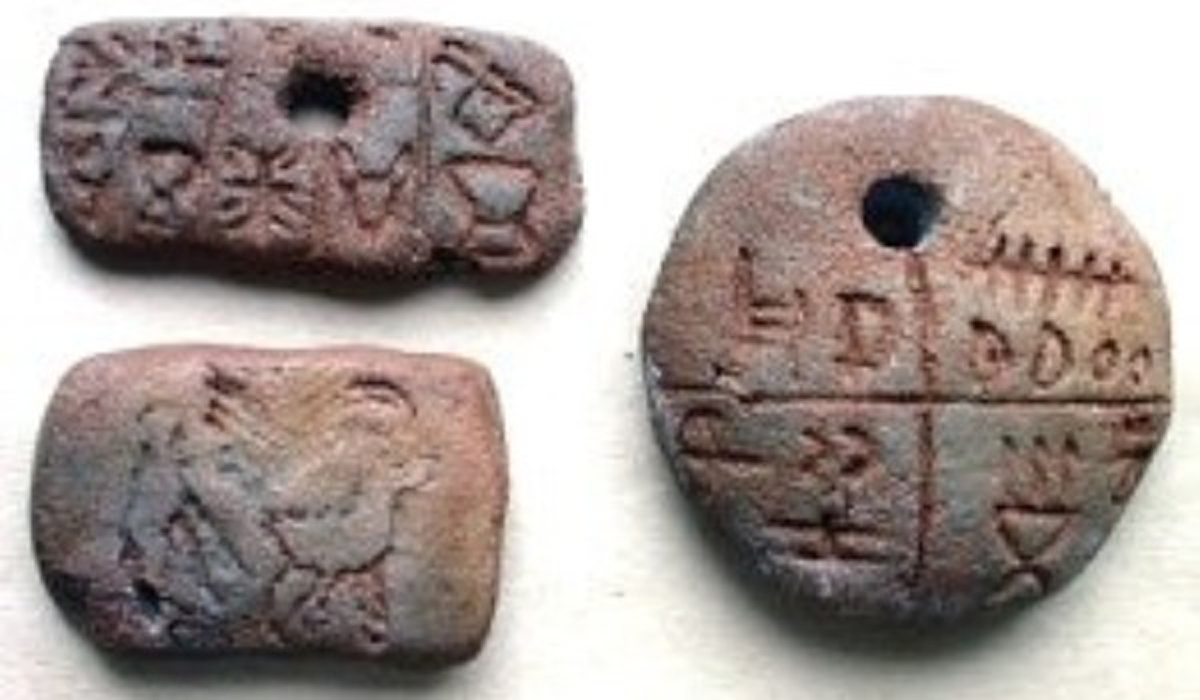
See Ancient Wisdom: The Vinča Culture.
No written records have been found, but they did leave us the inscribed tablets found in Tărtăria, Romania, dated to about 5000 BC. Archaeologists have found hundreds of tablets with similar symbols, from sites all across the Old Europe landscape. Some have posited that they were stamps for particular schools of pottery or metallurgy, others that they were mercantile trademarks or tokens used as a form of currency.
Having done some research on the ancient Irish astronomical inscriptions, I wondered if the Tărtărian inscriptions were computational or cosmologic.
The video below narrated by Keith Massey, a former linguist at the U.S. National Security Agency and an expert in the techniques of encipherment and decryption, applied his knowledge to a study of the patterns in the tablets. His findings are enticing. I hope research is continued along the lines he has opened up. The tablets may be the earliest known form of accounting.
There is another video (four times as long) focused on the ancient Varna culture that describes the mathematical precision inherent in the artifacts, narrated by Dr. Hristo Smolenov, a Bulgarian mathematician. Dr. Smolenov at times calls up a national pride and mythic connections ("a race of titans" with "hidden knowledge," a "sacred science"), which with the mood music is distracting. I've included the video here because the mathematics ring true, there is a coded system of knowledge embedded in the artifacts. It's just that I see this as evidence of the human brain's wonderfully endless capacity for discovery and creativity—mystery enough!
How They Lived
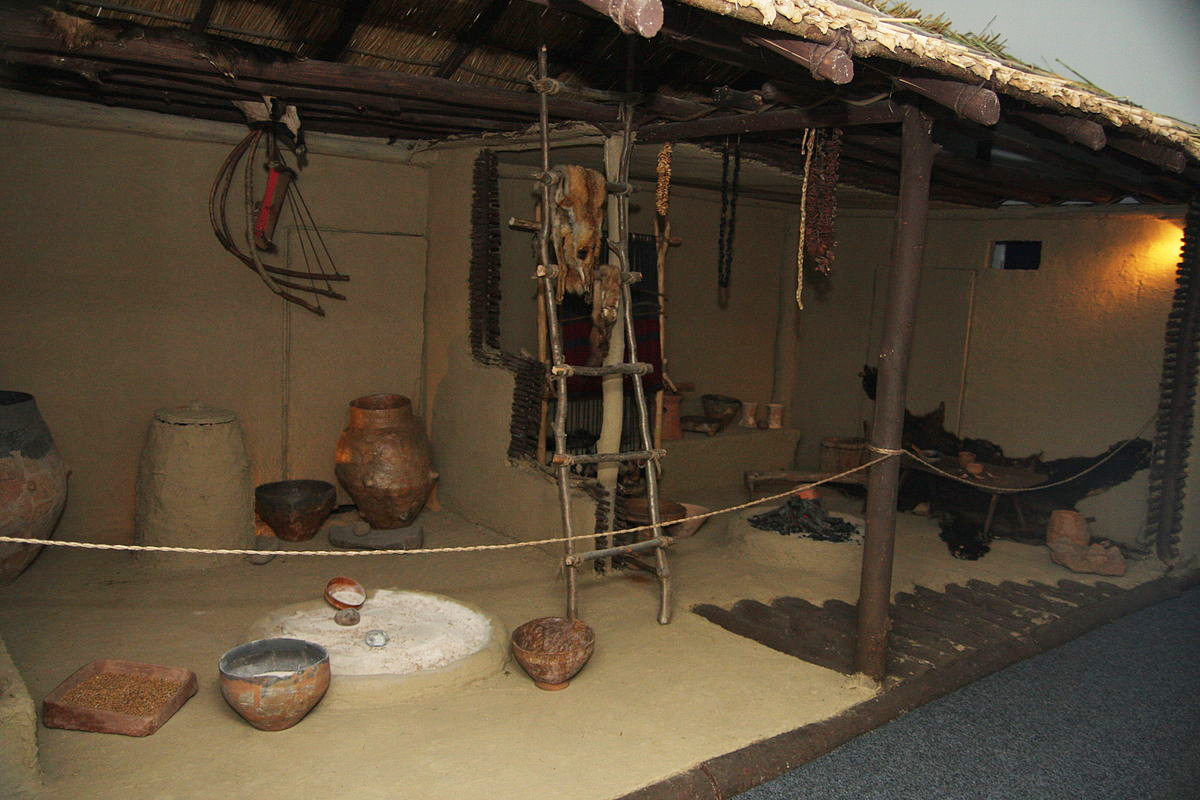
Pre-Cucuteni, Cucuteni, and Cucuteni-Trypillian Europeans had rectangular, one- or two-room thatched roof homes framed with timber, with mud brick and timber walls (some were a clay and sand plaster mix), with ovens, fireplaces, and often a second story. From about 5800 BC to 4800 BC, writes John Chapman, an archaeologist of prehistory at Durham University, communities in the lower Danube Valley lived in small and more dispersed settlements, but a more stable settlement pattern developed after 4800 BC (see Chapman, Lost World, pp.79-80).
Communities along eastern Black Sea shorelines built their homes in the tell style, closely set. Tell comes from the Arabic تَل, or תֵּל in Hebrew, pronounced "tall" and meaning, literally, hill or mound. Tell communities had a connection to Near Eastern style community-building.
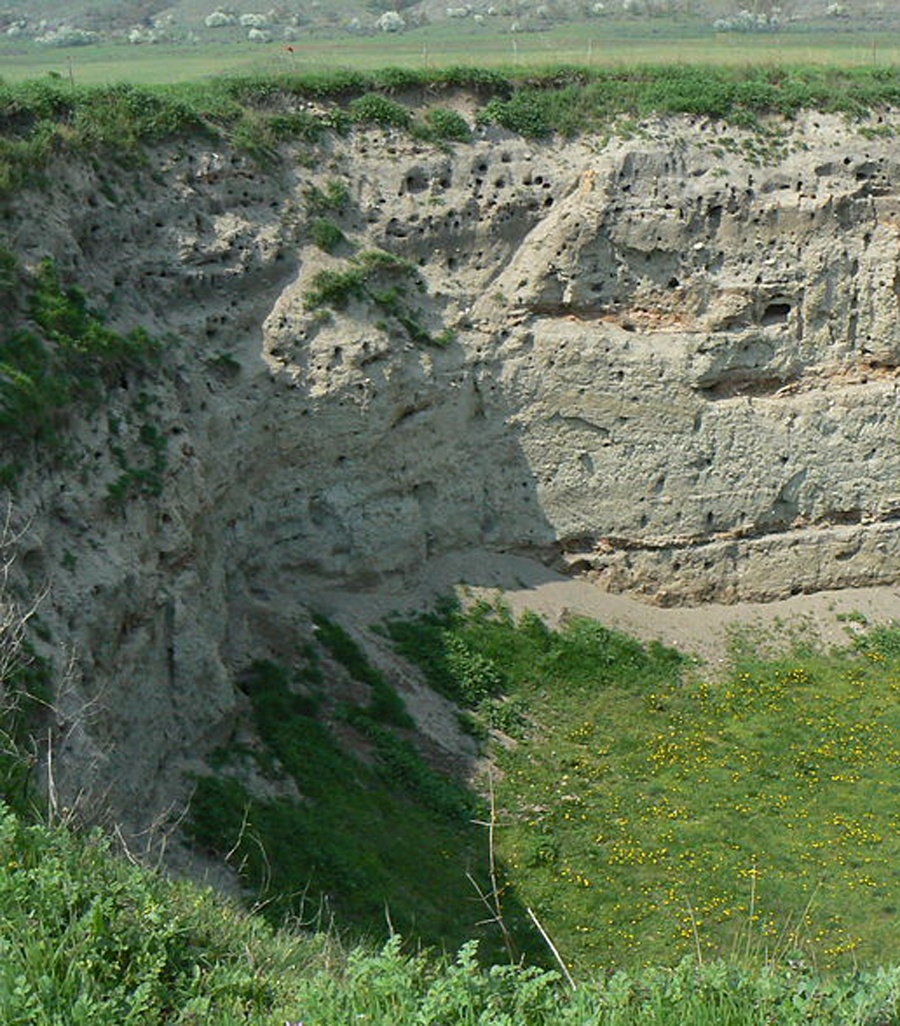
A tell, or mound, is created over generations, as the inhabitants burned their homes along with their contents after a few generations, and rebuilt from scratch. The famous tell at Karanovo in eastern Bulgaria (see photo) has a depth of about 40 feet and covers 10 acres of land. Its strata show evidence of early to late neolithic habitation over a couple of millennia (see Cunliffe, p.103).
What does the burning mean? There are both religious and practical theories. Burning was a tradition whose origin is lost.
The religious point of view posits that the house, its ceramics and other perishables have a renewable circle of life together, so the burning and rebuilding was a rite of death and rebirth. This view imputes great significance to the household items. They were personal, intimate, part of the homeowner who has gone or died.
The practical view is that over time houses and goods suffered disrepair, and the custom was for new homesteaders to build anew. This view too has room for the sacred. Even today religious homeowners will have their priest or rabbi come to bless their new house. We "re-do" our new homes to make them ours; we bring "housewarming" gifts on visits to friends' new homes.
Old Europeans made architectural models of their houses before they built them. The photo below is an actual ancient model showing homes attached like townhouses, with a surrounding barrier or wall fortification. Scholars aren't in agreement on the meaning of these barriers. Were they protection against attack? Did they keep farm animals from straying and safe from predators?
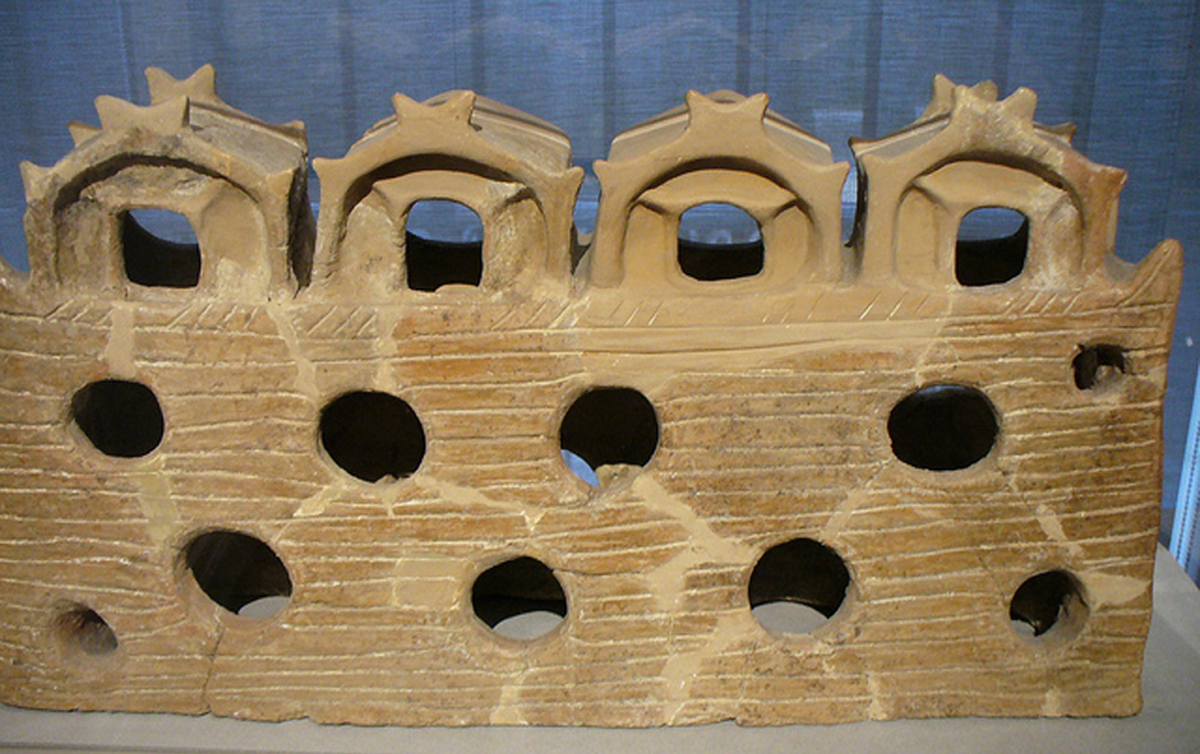
The interesting thing to me is that tells did not allow for much outward expansion. Some archaeologists have speculated that tell communities, where space became restrictive over time, not only reinforced the inhabitants' sense of belonging, but stood to keep unrelated groups out.
This explanation could be true, but it also puts the cart before the horse. If it was traditional to rebuild on the plot of one's ancestors, then over time the community became exclusive by default.
Flatter settlements called "terraced" layouts were constructed along high river terraces on the western shores of the Black Sea and further north in areas in present day Serbia and Hungary as well as Romania and Ukraine. The terrace layout allowed for the expansion of garden and farm areas as well as future population growth. Tells and terraces both had elliptical layouts that grew outward from a central communal structure.
Old European households were self-supportive. Families worked in their homes. Kilns were kept in the same space in which the family ate and slept. Think about this. The family was the basic, the most important, unit of society.
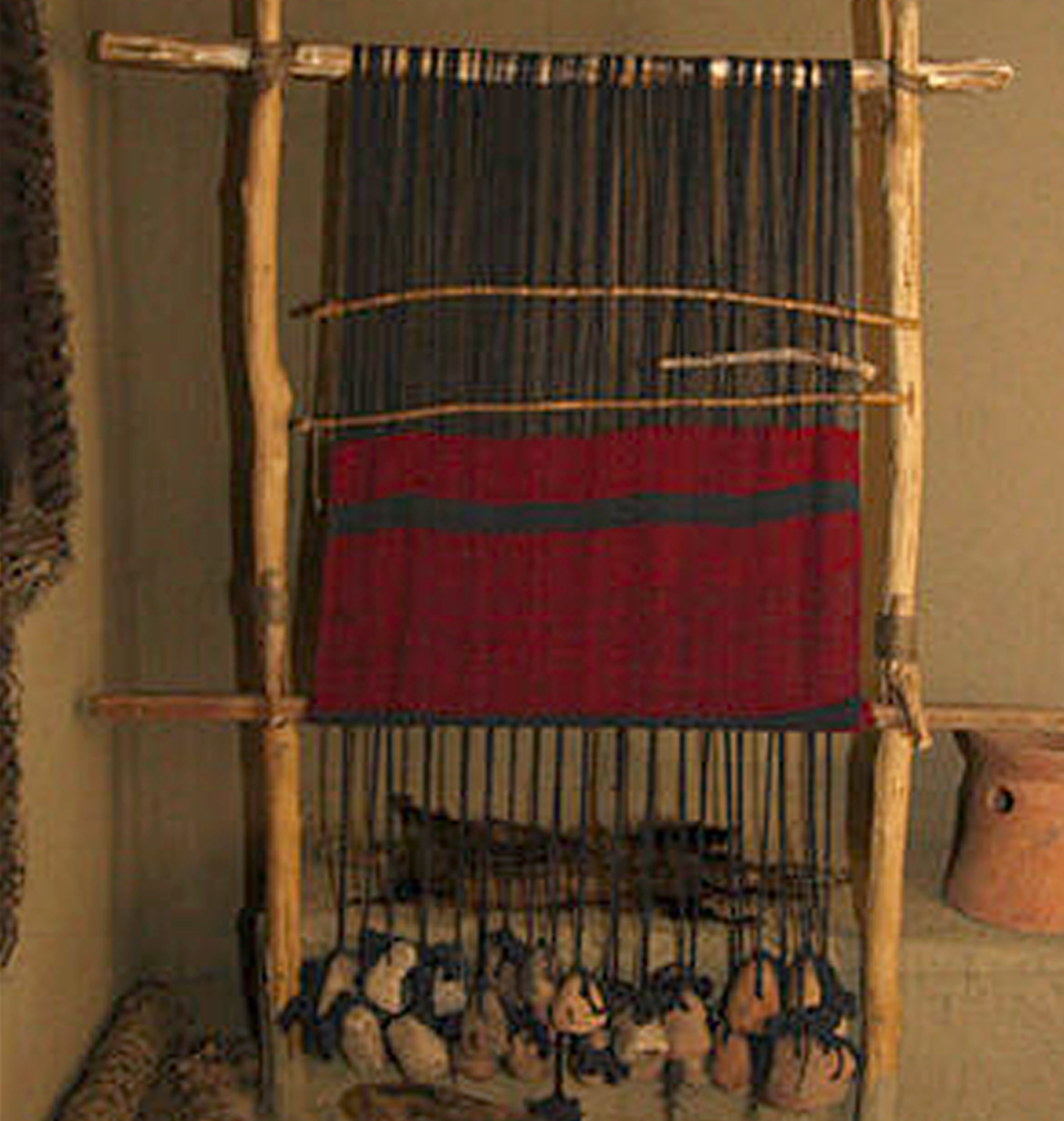
Specialization up until the Copper Age was often a family affair. A family might have specialized in ceramic pottery; flint, gold, obsidian, copper or other metal processing; stone axe polishing; stone grinding and grain milling; textiles; even fishing, shell gathering, and bone carving. There was an expansive economic diversity to these activities that feels modern. A high level of of quality across the economic product spectrum was maintained.
In the later Cucuteni and Cucuteni-Trypillia eras, starting about 4500 BC, settlements got larger. Manufacturing became more formalized, with workshops getting built at the margins of many communities. This eventually led to some community specialization —in which different settlements worked in different parts of the economy, not only in pottery and metal production, but in cattle breeding, hunting, and farming products. The home kept its importance for making personal wares such as household ceramics and the many figurines (mostly female) found throughout all neolithic settlements.
Terraced communities faced a difficult reality. Chapman notes that the western Black Sea coastline was much lower in 5200-5000 BC than it is now and that "some of these western Black Sea neolithic settlements might now be under water at a substantial distance offshore." (Chapman, Lost World, p.76)
This idea is widely believed; rising floodwaters are one theory as to why this culture was widely diminished during the Bronze Age. Most likely, many artifacts lie in the depths of the Black Sea.
Archaeologists always look at gravesites for important information about early cultures because of the importance everywhere attached to the realm of the dead. But in Old Europe, burial practices are not easy to explain.
The Hamangia culture, the earliest of Old Europe, adopted mesolithic customs of in-ground burial, adding anthropomorphic vessels and figurines and other valuables. But the Gumelniţa, who were part of the Hamangia culture, often buried their dead under their homes or in a plot attached to the home.
In western Romania in what is called the Tizapolgár culture, cemeteries dated to 4500 BC show male bodies buried rightward and female bodies leftward, with pottery, tools, weapons, and valuable bodily ornaments.
In the pre-Cucuteni and Cucuteni cultures, archaeologists have not found evidence that the dead were buried. Disparate human skulls and other human bones have been found, but no cemeteries, and researchers think the bone deposits were attached to ritual practices.
Cremated human bodies were found in the debris of intentionally burned homes. Cremated human remains, notes Popovici, were "placed in pits together with pottery fragments, pieces of charcoal, and stone artifacts, all burned in a secondary postcremation ritual" (Lost World, p.105).
There were several empty, symbolic tombs at Varna, containing unbaked clay masks along with the richest gold deposits ever found anywhere, presumably dug and filled for nonreturning heroes.
The Cucuteni-Trypillia culture did not bury their dead until the later stages of their culture, about 3300 BC. At this time, some Cucuteni tribes would place several corpses in stone cists, small coffin-like boxes built of stone and placed in the ground, with tools and weapons.
I find this variety of burial practices unusual for regions that otherwise had shared traditions. We cannot really know the beliefs and practices of these cultures as they handled their dead. The sculptures that open this article tell tales of sorrow on an intimate level, however, carried to the graves, under the homes, and amid the ashes of the beloved departed.
Across Old Europe there was an "astonishing diffusion" of Spondylus, notes Michel Louis Séfériadès of the French National Centre for Scientific Research in Paris. Its life was storied.
What is it? It is a shell found in the Mediterranean along the Aegean and Adriatic Seas whose use goes back to the earliest neolithic Greek farming communities of 7000 BC. At first ornamental, it became used along Old Europe trade routes and exchange networks as a unit of value.
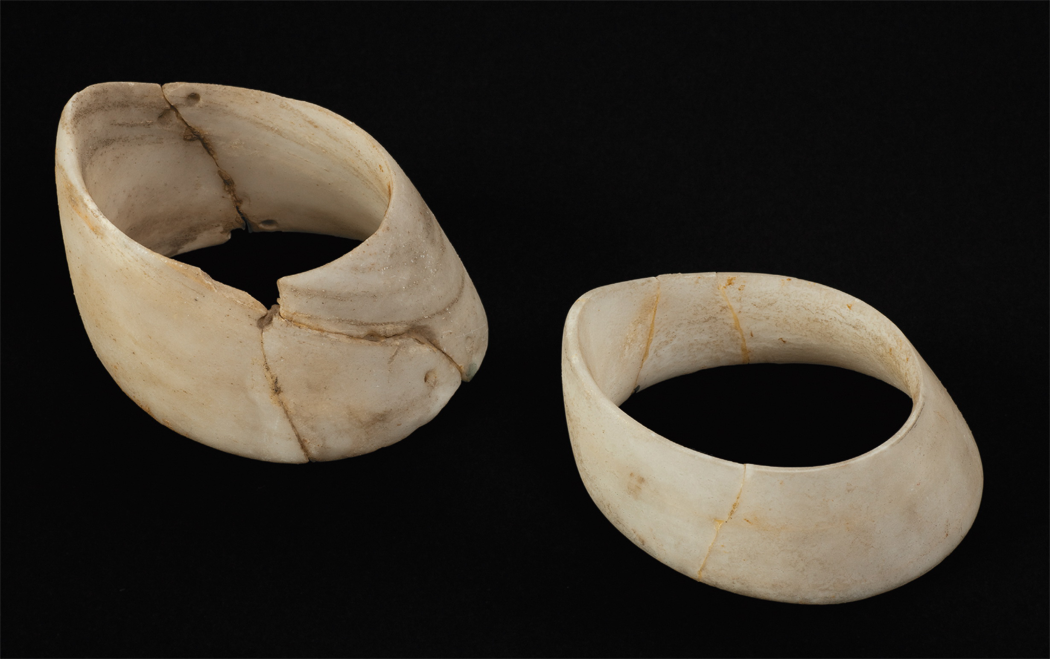
But was its value primarily mercantile? Some Spondylus artifacts were combined with cut and polished stones to create beautiful objects, and were found in rich grave sites with other valuables. The objects have a great variety of forms, shapes, and types, over three thousand years (6500 BC–3500 BC).
Mr. Séfériadès notes:
As the microstructure of the shell is formed from calcite and aragonite, the large valves ... offer an ideal material for working, sculpting, and fine polishing, to produce objects for the adornment of clothing and the body. (Lost World, p.180)
Archaeologists agree that Spondylus traveled a southeastern to northwestern route, starting from the densely populated neolithic Balkan settlements. The shell traveled far from its origins, across the Carpathian Mountains to Bavaria, through Germany to northern France and the British Isles. The fact that this shell traveled so widely, far from its origin, is a testament to the worldliness of the Old Europeans.
But there is another aspect to the wide appeal of Spondylus. The farther it traveled from its Mediterranean origins, the more it circulated.
It took on properties—of form, shape, and meaning—of the northern peoples who, Mr. Séfériadès notes, developed a superstitious attachment to it.
The shell was much more important in interior Europe than it ever was in Greece, he says. The "various miscellany" of Spondylus objects were likely the ritual accessories of shamans. The objects—multiperforated valves, pectoral pendants, vulva shapes—were worn from use, passed from generation to generation, never destroyed like the wares intentionally burned in a house burning.
The northern people used them the way beads and ornaments were used
... at the closing of the Paleolithic period and during the Mesolithic. These hunting and gathering cultures form a cultural subcontext of the European processes of Neolithization, to which in the Neolithic are added Spondylus artifacts that represent a new reality layered on top of old myths. (Lost World, p.187)
The figure below is a drawing of a Spondylus shell found in a neolithic grave, with what look like etched letters and shapes. The symbols bolsters the idea that Old Europe had some form of writing.

Michel Séfériadès's hunches are plausible. A shaman is a healer. The Spondylus objects may have been used in healing rites. If you impart sacredness to an object, then focusing on it provides a temporary release into a different realm of consciousness. Life wasn't easy in neolithic times; the "sweat of one's brow" and the hope of good outcomes for one's sweat were immediate everyday concerns. They still are for us, but we have the gloss of modernity to shield us. How deeply do our superstitions, needs, and desires still run?
Smelters and Metallurgists
There is no other way to say it, the Old Europeans were gifted metallurgists.
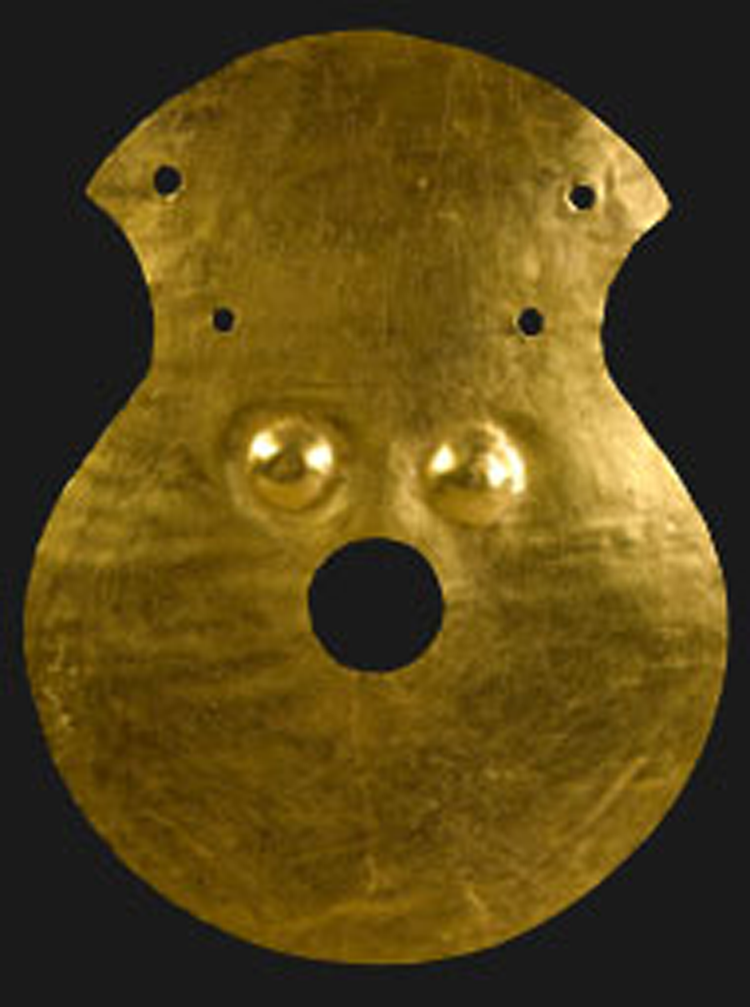
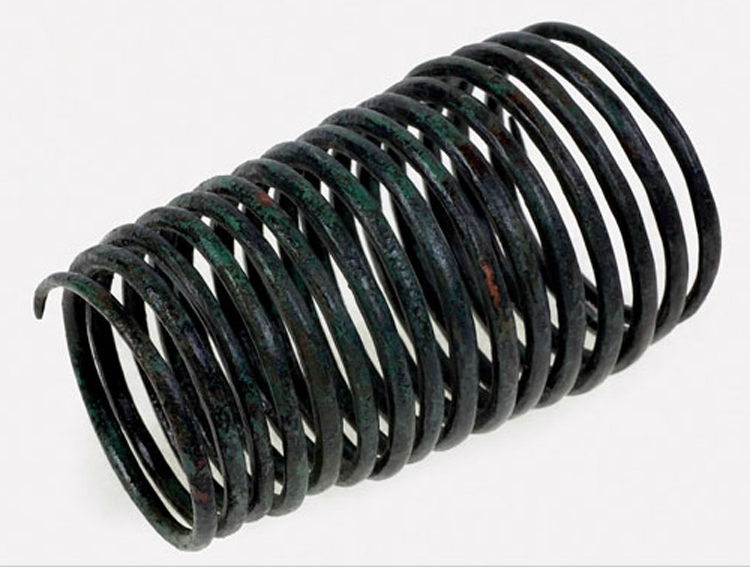

Photograph © Jurie Foca & Valery Hembaruc.
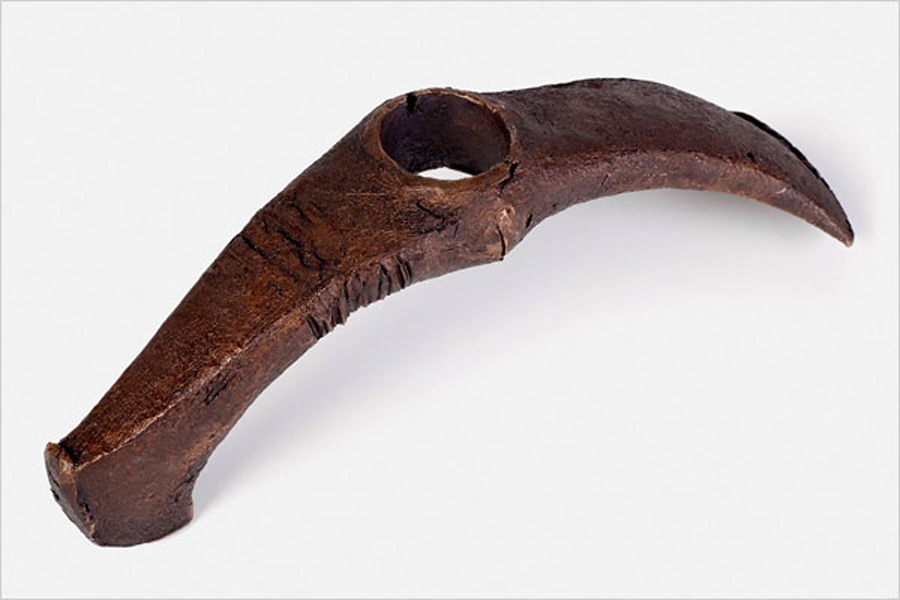
Not only was production indigenous, it was old:
Not so many years ago, it was generally assumed that European metallurgy was derived from the Near East ... But the initial widespread application of radiocarbon dating in the 1950s and 1960s produced a chronology for the Balkan Copper Age that was much older and began much earlier than had been thought possible. ... which suggested that the production and use of copper in the Balkans was an indigenous, independent, or nearly independent development. (David W. Anthony, Lost World, p.168)
The village of Starčevo on the north bank of the Danube in Serbia is where the the oldest native copper in southeastern Europe was found, and the earliest uses of the metal were for awls, fishhooks, and rolled wire beads, dating as far back as 5800-5600 BC.
Hoards of cast copper axes and chisels discovered at Pločnik, Serbia, dated 5500-4700 BC give evidence of copper's abundance (Pernika & Anthony, Lost World, p.169). Prehistoric copper mines already in use by 4500 BC were found in Rudna Glava and other sites in Serbia and Bulgaria. There were huge quantities of azurite and malachite, ores used to smelt copper, in the Balkan mountains. Dragomir Popovici, a Romanian archaeologist and cultural anthropologist, notes that the Copper Age culture in western Romania, extending onto the plains in Hungary, dates from 4500–4000 BC (Lost World, p.91).
We can see why archaeologists do not agree that early metal-working centers in Anatolia, the Levant, and Iran influenced the metallurgy of southeastern Europe. In fact, southeastern Europe is distinguished in the ancient world by having the largest volume of early gold and copper artifacts ever found, in an amount that "far exceed[s] the known production of all contemporaneous inventories in any other region" (Pernika & Anthony, Lost World, p.169).
Metals from the mining sites in Old Europe were transported to smelting sites in the settlements—miners did not process ore at the mines. It was to their advantage to trade ores from different mine sites and to exchange ideas on processing the ores. One interesting result of metallurgical experimentation was their discovery that a tiny bit (about one percent) of arsenic added to the copper made for a stronger, less brittle metal with harder edges (Pernika & Anthony, Lost World, p.169). The professionalism and vitality was highly sophisticated.
The Ai Bunar mines in the Balkan Mountains:
[W]ere excavated at eleven different places into a rich vein of malachite contained in limestone, marl, and diorite. The mines were open trenches cut into the rock, ten to eighty meters long and three to ten meters wide. ...in some places they reached twenty or even thirty meters (more than ninety feet) in depth.... Tools discarded in the trenches included more than twenty fragmented picks made from red-deer antler, very large hammer stones, and two heavily used cast copper tools, a hammer-axe and an axe adze. ...[The] mines likely were operating by about 5000 BC. (Pernika & Anthony, Lost World, p.170)
Late Copper Age dates are from 4700 BC to about 4200 BC, when production at the Ai Bunar mines slowed and ore sources near the southeastern Bulgarian coast were more exploited. One coastal mining settlement at Sozopol is now fully submerged in the Black Sea. The gold found at Varna came from two different sources in southern Bulgaria, and it differed in terms of platinum and silver content. Half of the gold found at Varna came from coastal sites along the Black Sea. The prosperity these cultures enjoyed rivets one's attention, especially as there seems to have been some egalitarianism in place in Old Europe.
Those Female Figurines
The figurines. They elicit more theories than any other Old European objects. They hold power—over us! There is a lot of discussion, but less agreement, about their meaning.
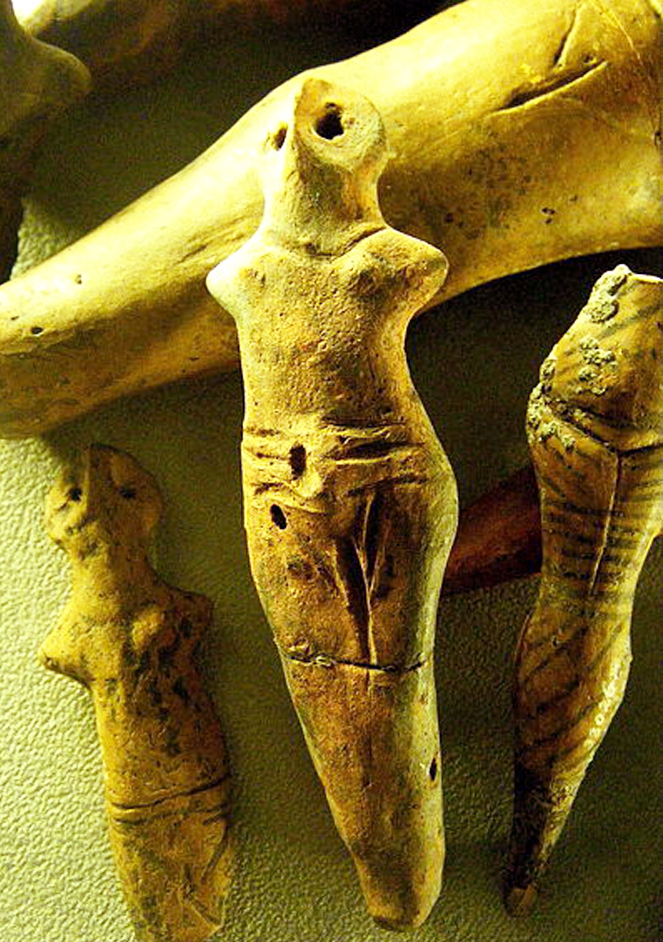
Are they the heiresses of the extremely old European mother goddess figures who are all breast and belly or vulva (clearly fertility related), dated several thousand years before them? A bit unlikely, because many of these figurines are slim and attractive in a modern way. Many are small breasted. They're wearing clothes, some with the popular design motifs found on the ceramics.
That women had a place of honor in this culture seems secure. All homes had these figurines; archaeologists have found hundreds of them, sometimes as much as seventy in a single dwelling. They were products of the home—made in the home, belonging to the family. Children could have made these figures with their mothers, styling them as they liked. They have also been found placed underneath homes, like a charm bringing warmth to the hearth. They were sacred, but in a way that you could hold, touch, and play with.
Look at the circular group of female figures below. When I first saw these at the ISAW exhibit, my heart took a small leap. They did look like the women's roundtable, the meeting of the goddesses, the decision-makers at work. I thought, what power women had in this culture!
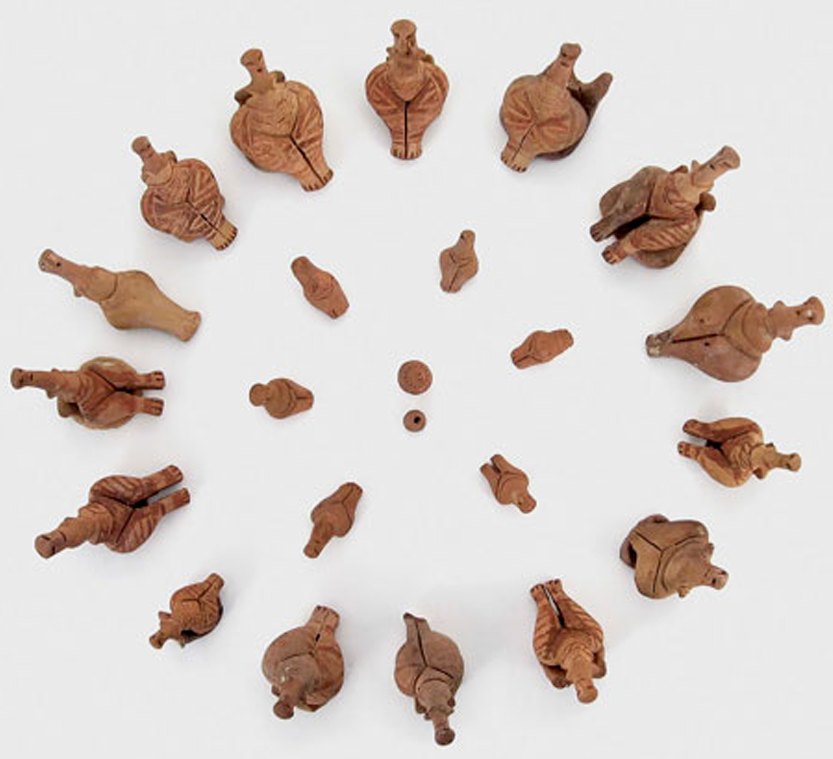
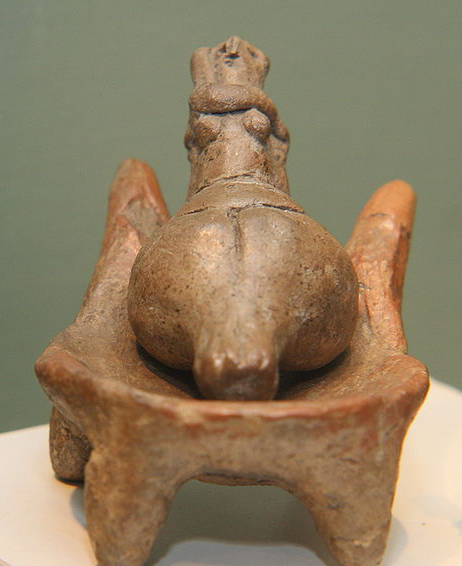
This figure is from the group above. She seems to be the most important figure, with her arm reaching across her chest in an authoritative stance.
The image below is yet another group of figures, found in the container as shown.
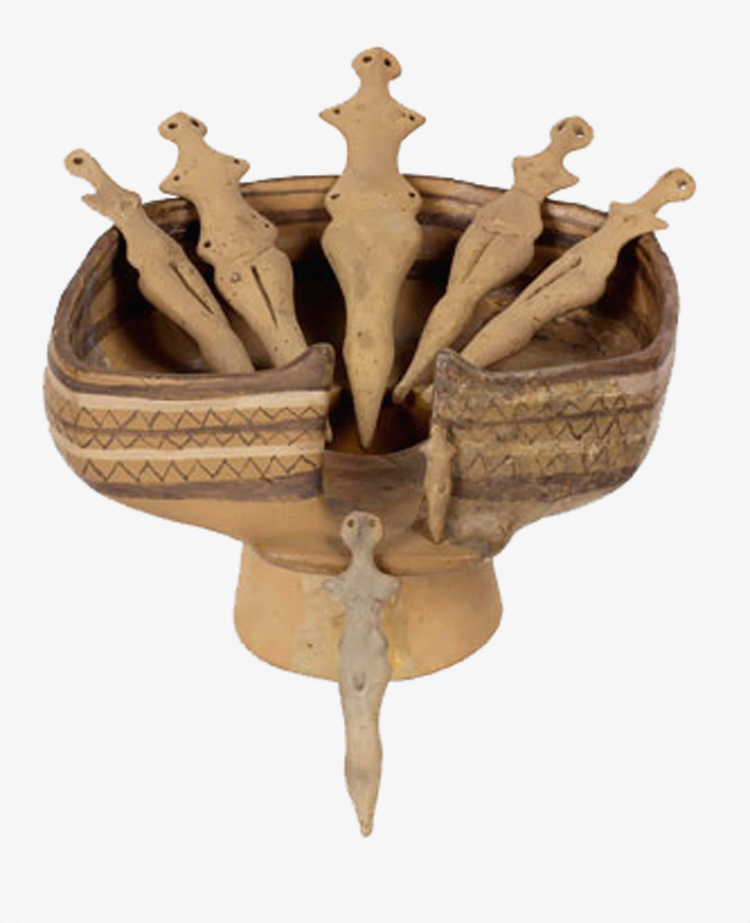
While marveling at these sculptures that were unlike anything I've ever seen, I noticed a similar grouping of twelve figures, and half of them were male. Oh, I thought, these people were so democratic! There were women's roundtables, and there were mixed decision-making groups! The image below shows only two of the figures from this set, female and male.
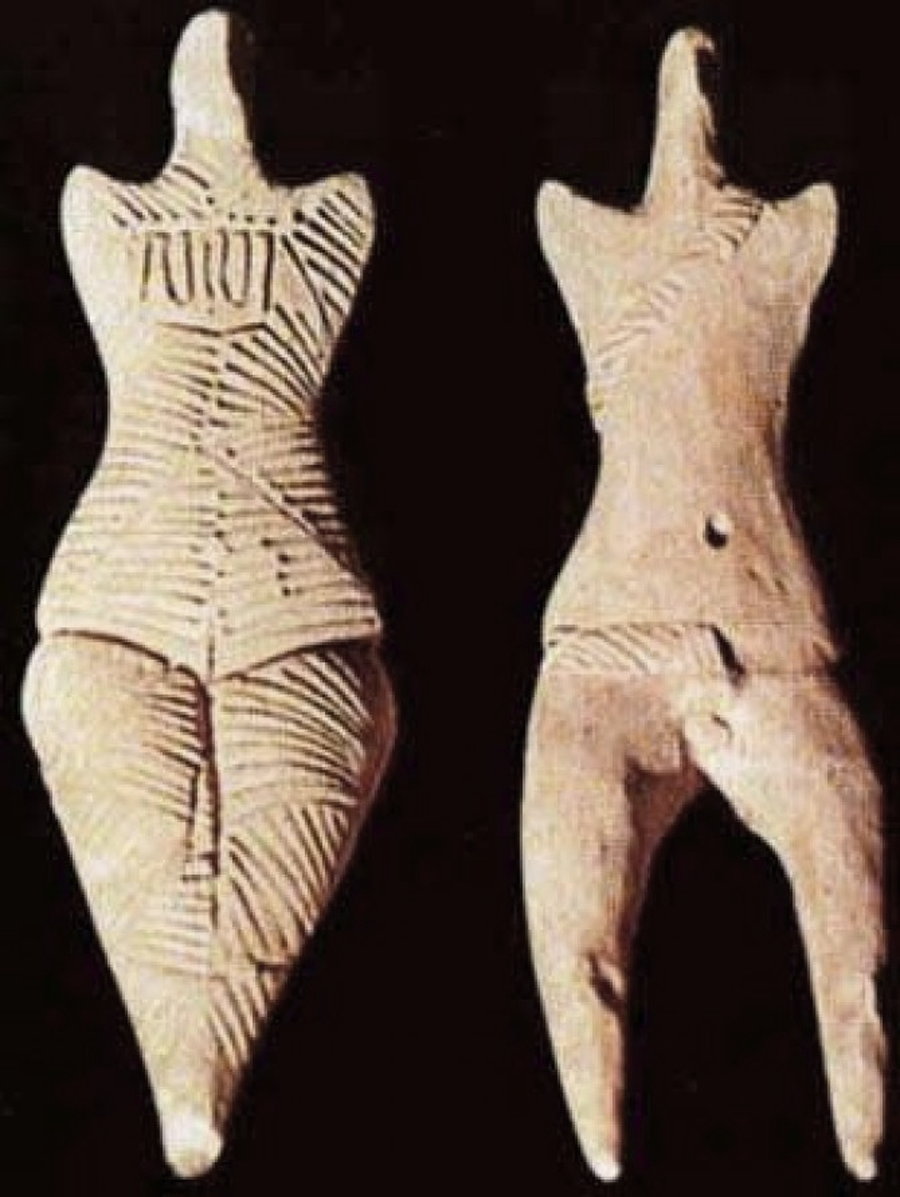
These groupings are very interesting. The figures are small. As I stared at them, still stunned by their evocativeness, I started to wonder if they were game pieces. This culture was advanced, material; family time likely included game time. If the figurines were games pieces, then within each cluster the larger and smaller figures, the chaired and unchaired figures, the male and the female pieces, all had different values and roles in the game.
There is quite a variety of types of female figurines. Some are heavy in the thighs, like mother goddesses; many have thin torsos. Were the single figurines dolls? This would not discount their sacredness. If anything, the Mattel Company's Barbie doll has been a goddess of beauty and love, an Aphrodite, for generations of modern girls who dressed and redressed her in their own image. That realm goes deep.

The figurines cannot be given only one interpretation. There are bird, bull, ram, bear, dog, goat, turtle, hedgehog, and other undefinable zoomorphic figurines that came straight from the imaginations of the sculptors. Some look like toys, some like the aesthetic bric-a-brac we place on our shelves. But there are some that have an aura that puts them in a different realm—look at the otherworldly beauty of the bird goddess figures in the photo.
A Wikipedia site on the religion and rituals of the Cucuteni and Cucuteni-Trypillia is a nice overview. Douglass Bailey, in his chapter on the female figurines in the Lost World catalogue, notes the diversity of size, dress, and style of these beguiling figurines. They are sacred, but they are personal. He even notes a Barbie doll connection—an interesting surprise to me—as he muses on the psychological shifts in concentrated play:
[S]omething happens to the human mind when one handles or plays with miniatures objects. ... when we focus our attention ... we enter another world, one in which our perception of time is altered and in which our abilities of concentration are affected. (Lost World, p.122)
When the people of the Pre-Cucuteni world placed the bodies onto the little chairs, when they arranged and rearranged them in different settings, they were entering other worlds, he says. Were they spiritual worlds? Well, such play is private and calls on the subconscious. We cannot be precise about their use, but the function of the figurines
is to be found at a deeper level of reality, upon which the community constructed and maintained a sense of who one was, what one should look like, and how one was distinct from others. (Lost World, p.122)
The culture of Old Europe, so full of artistic and material invention, produced so much it's dizzying. The work has a "signature look," a sure sign of mature art. But we don't know how symbolic all those artistic motifs, zoomorphic vessels, figurines, and models were. Why were their burial rites so varied and curious? What about those skull deposits? What did they believe and what rites did they practice? So much of their everyday life remains elusive.
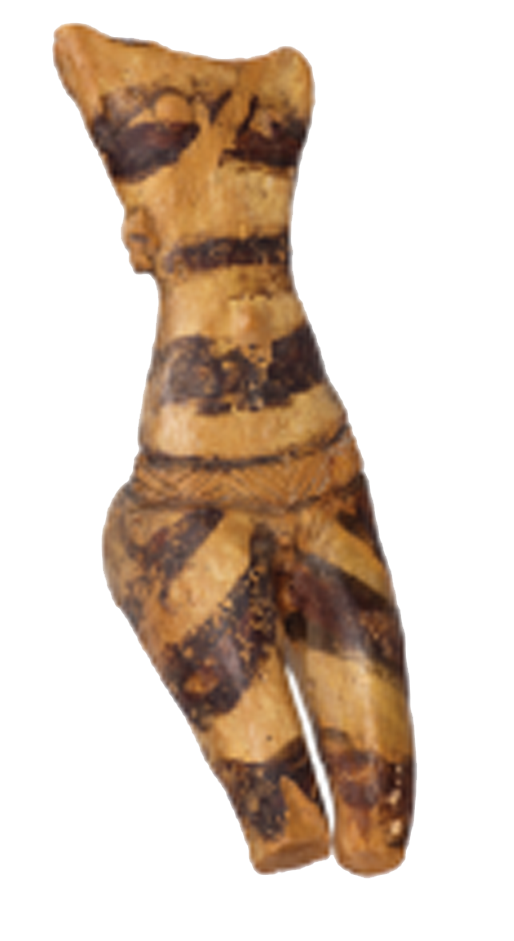
Here is the original New York Times article announcing the arrival of the ISAW exhibit. It was a long time coming. The 1980s were the last decade of the communist regime in Romania. Up to then, archaeologists in the West did not have access to Old Europe archaeological sites. Scientists and archaeologists did not know what their counterparts in eastern Europe were doing. I am grateful for the hard and honest work of all the people involved to get this exhibit to the United States.
This civilization ended abruptly, say several experts. David Anthony notes that by 4100 BC, more than 600 tell settlements in the lower Danube Valley were burned for good and abandoned (Lost World, p.45).
One theory about how this civilization ended, sometime around 3200 BC, is that invading, warlike peoples from the eastern steppes moved in and destroyed it. But the Old Europeans were multicultural and spread over a huge territory. They were already into the steppes and they shared a long history of cultural interchange and integration.
Another theory is that about 4200 BC, glacial movement in the Alps produced a cold spell unlike anything experienced in the past few thousand years, with frequent, severe flooding. A third theory is that rising water levels in the Black Sea between 4200 BC and 3600 BC drowned out the settlements on the coast, which is true.
But the story of Old Europe's end is also elusive. As tell settlements and customs waned, the Cucuteni-Trypillia culture moved eastward further into the steppes. By 3400 BC there were huge settlements east of the South Bug River, still with an elliptical shape fanning outward from the center.
These communities were also burned and abandoned by 3200 BC, replaced by mobile pastoral herders on horseback from the East who spread into the South Bug Valley and migrated up the Danube into Bulgaria and Hungary.
I noted in the Ancient Astronomers article that a genetic study of 4300-year-old skeletons found in Ireland show that they came from the Ukrainian steppe. Some Old Europeans who abandoned their sites likely already knew about Ireland; they may have heard stories from the seafarers making the Atlantic journey and decided to relocate. Irish metallurgy developed into an exquisite art; Old Europe may have been its source.
One final thought. As I was researching why this culture appeared to have an abrupt end, I found the blog (I should have saved the link) of a young Romanian woman who had a wonderful answer. She wrote,
We're still here.
References & Works Cited
David W. Anthony, ed., with Jennifer Y. Chi, The Lost World of Old Europe: The Danube Valley, 5000-3500 BC (Institute for the Study of the Ancient World at NYU and Princeton University Press, 2010).
Barry Cunliffe, Europe Between the Oceans, 9000 BC–AD 1000 (Yale University Press, 2009).
Andrew Curry, "Glitter From a Lost World," Smithsonian Journeys (Summer 2016).
Settlements of the Cucuteni–Trypillian Culture (© Revolvy, LLC).
Romanian History and Culture (© 2009).
Comments? Please send your responses
on the site's Contact page.Thank you!
